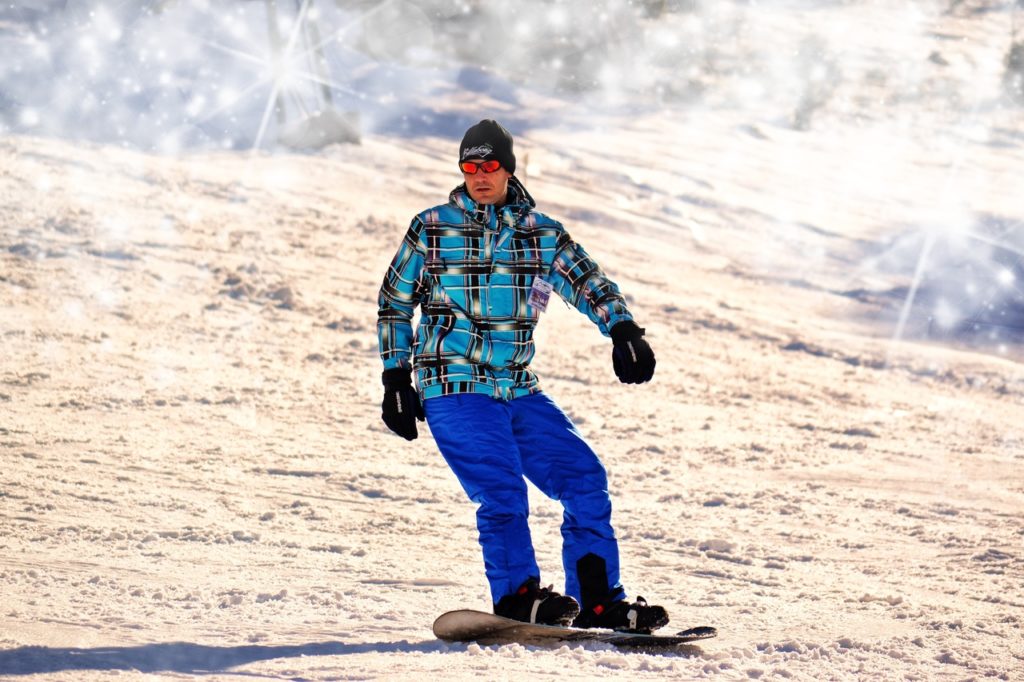It's never too late to buy a snowboard. The season is just around the corner, which means it's time to upgrade your equipment or choose your first ever board that will open you up to the wonderful world of snowboarding. The choice of equipment is a crucial stage. Not only riding comfort, but also the life and health of an athlete depends on its correctness.
There are many types of skating boards. There are several main disciplines in snowboarding that place demands on the characteristics of the equipment, such as length, width, shape of the front and back. Each of the riding styles has its own peculiarities that impose requirements on the characteristics of the equipment.
To understand the technical characteristics of the models, it is useful to know how the snowboard works in general. Without this, the terms used by sellers in stores and product cards on the Internet will be incomprehensible.
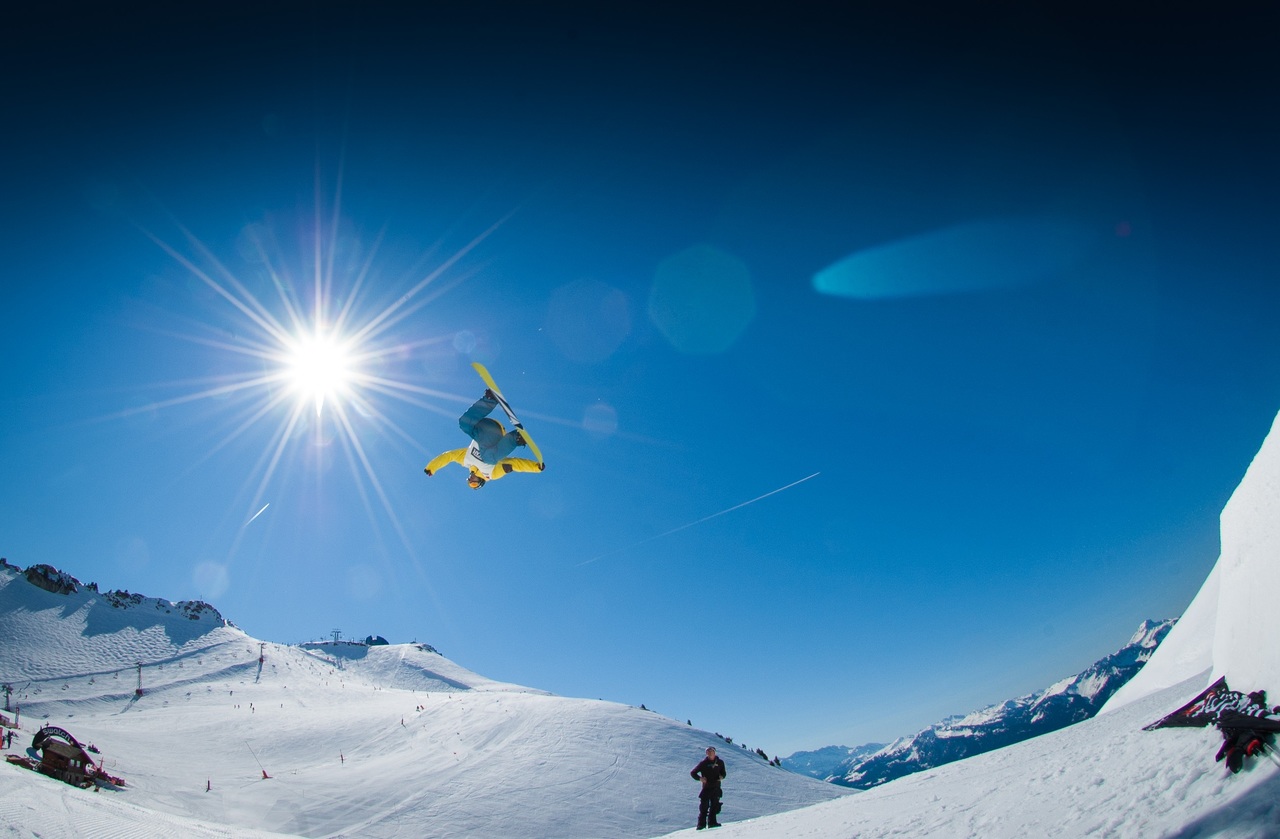
Content
What does a snowboard consist of?
Core
The main part of the board that determines the behavior on the track or ramp. It was originally made of wood. Wood gives the product elasticity and stability. The most commonly used variety is spruce, as it has an optimally balanced strength and resilience. Over time, manufacturers began to combine wood varieties, alternating varieties of different densities, alternating grain directions, overlaying several layers of wood of different species. A solid wood core can be deformed by stress, temperature or humidity. Glued structures are devoid of these disadvantages.
Wood core snowboards are stronger, more stable to use and more responsive to movement. However, they are more expensive and heavier than their composite counterparts.
With the development of technology, the material from which the core is made has also changed - polymers and plastic were used. This made the design cheaper and lighter.
There are two types of core construction:
- Sandwich - from above and below the core is pasted over with fiberglass or plastic, while the edges are closed with a plastic strip. The resulting design is flexible and easier to repair.
- Cap - The core is wrapped in layers of fiberglass. The product turns out to be more rigid. The cap structure is harder to repair; under extreme loads, the boards often delaminate.
There are hybrid designs where the two types described above are combined in one product.
Bottom surface
The bottom surface, also called the slide or base. Made of polyethylene. They are divided into two types:
- Stamped or extruded. The material is obtained by rolling through rollers of molten polyethylene mass. It does not require special care, has a low price and is easily repaired when scratches occur.
- Sintered. It is obtained by sintering small polyethylene granules. This results in a porous surface. Requires more careful maintenance, mandatory paraffin impregnation and lubrication to improve sliding.A sintered polyethylene base is more wear-resistant than a stamped base, and with the correct impregnation and selection of lubricants, it has better sliding. At the same time, such surfaces are more expensive and more difficult to repair - damage on the sintered base cannot be repaired on your own - a high temperature, special repair equipment is required.
Kant
A steel strip wrapped around the bottom edge of the board, cutting into the snow. If the edging is thicker, the whole structure is stronger, if it is thinner, the weight is lighter. The rider is always faced with a choice between strength and lightness. In cheap models of snowboards, the edging is placed only in the side working areas, in expensive and advanced ones, the edging protects the entire perimeter of the snowboard, trying to get by with a single seam.
Deflection or profile of the snowboard
If you look at the board from the side, you can see that it is curved, some parts are in contact with the surface on which it lies, some are raised and do not touch it. How the snowboard is bent determines its behavior on the slope.
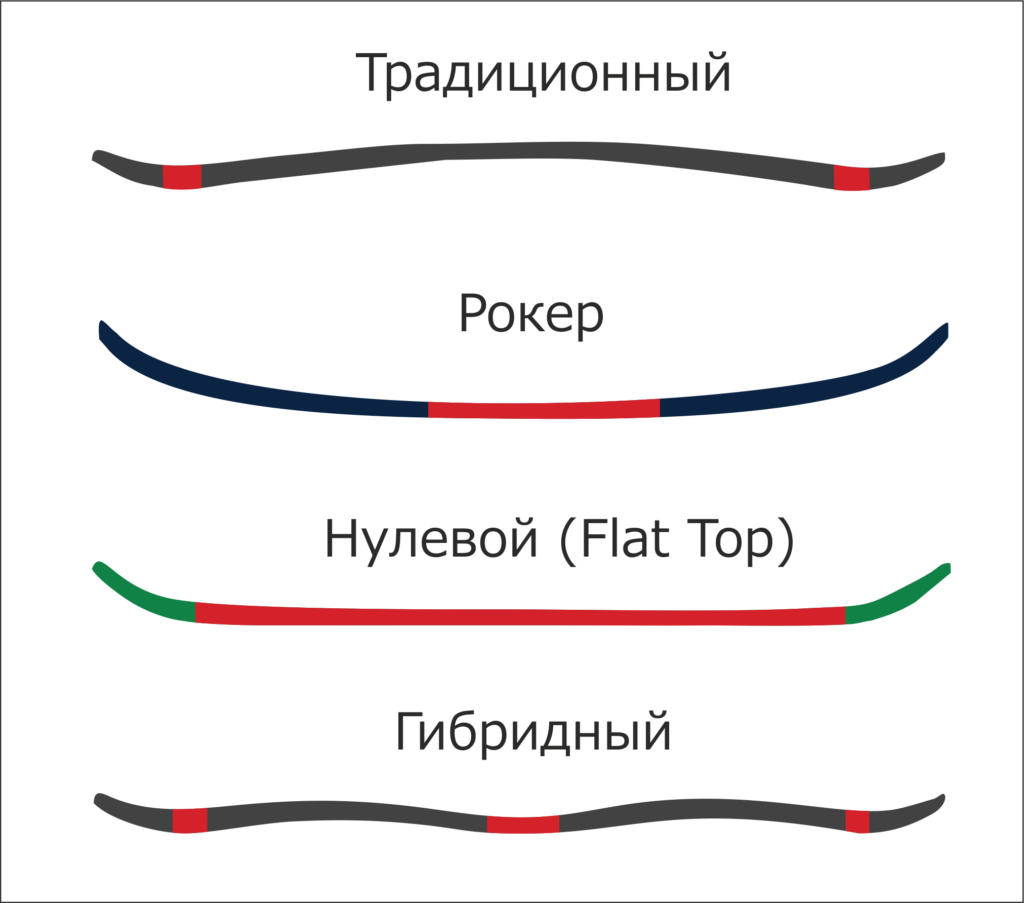
There are 4 types of deflection:
- Traditional deflection (Camber) - straightens under load, but when it is lifted from the surface, it returns to its shape. Provides stable handling.
- Reverse deflection (Rocker) - due to the fact that the edges of the board are raised, it is good for riding on fluffy and deep snow. Also suitable for some tricks if performed without a springboard. Not recommended for high speeds.
- Zero deflection - (Flat) -. Suitable for beginners and those who continue to improve their skills. Zero deflection boards are also often used for jibbing.
- Combined or hybrid deflection - a combination of classic deflection with reverse deflection. An attempt by manufacturers to find a universal solution for all disciplines. There are a lot of hybrid deflection options - manufacturers often come up with their own options and patent them.
Board geometry
Geometry or symmetry determines which direction the snowboard will ride best. There are three types of symmetry.
- Directional. Asymmetrical nose and tail, usually wider. The tail is cut off or less rounded than the nose. The purpose of such shells is to move quickly down and in deep snow.
- Symmetrical (twin-tip). The front and rear edges are rounded and raised the same way, so you can go forward with either side of the snowboard, which is important when performing tricks when after landing the rider can change direction.
- Hybrid (twin-directional). Similar to twin-tips, but the inserts are shifted towards the tail, thus the athlete's center of gravity is shifted back. By swapping the bindings, the snowboard gets a directional geometry, but if you place the bindings in the middle, it behaves like a twin-tip.
What are the different riding styles?
Freestyle
From English free style - free (free) style. Skating on prepared tracks with elements of acrobatics and tricks, somersaults or flips. Tricks are evaluated similarly to figure skating technique in terms of complexity and purity of performance. There is a basic set of figures, but every athlete is free to bring something new to the classical technique, to combine or complicate the figure.
Freestyle discipline, in turn, is subdivided into several directions.
Jibbing
Descent on various structures made of pipes, railings or ramps. The athlete jumps onto the structure, and slides along it on the middle part of the snowboard, set it at an angle of about 90 0.
The board for jibbing is chosen to be elastic, rigid in this case will be uncomfortable. The deflection is preferable classic or zero, it will allow you to more reliably hold onto an obstacle. During jibbing, snowboards often break or get damaged, so you should not choose expensive equipment for riding.
Backcountry
Skiing on unprepared slopes. Since the area is not equipped with lifts, they climb the mountain on their own. In some cases, boarders can be thrown to the top by helicopter, or taken by snowmobile, but the cost of such a transfer is usually high, and therefore not everyone can afford it. The way up is not easy, just as the descent is difficult and unpredictable.Deep loose snow, protruding stones, trees, and windbreak make riding dangerous and require a lightning-fast reaction from the athlete in making decisions. Of course, there is nothing for a beginner to do here.
Halfpipe
Half pipe (literally translated as "half pipe" or "half pipe") is an artificial bowl in the form of a gutter with two sloping walls or the letter U, up to 10 meters high and 30 and more long. Rolling down from one side, the rider slides down and, under the action of acceleration, flies to the opposite wall. At the top point, tricks or jumps are usually performed.
Halfpipe requires good board control and a sense of balance. If this is your first time on the ramp, evaluate your strength. First you need to ride from one side of the ramp to the other without tricks and jumps. The specificity is that usually the athlete goes down all the time, and in the chute the movement is divided into two phases - descent and ascent.
For a halfpipe, it is more appropriate to choose a rigid board (7 out of 10).
Which snowboard to choose for freestyle?
Free style, like a trick type of riding, imposes certain requirements on equipment, the board should be light, not rigid and fit the size. The main parameters are listed below.
Ease. Freestyle snowboards are smaller and lighter than classic snowboards. The construction uses several layers of material - wood or polyethylene on the outside, and polyurethane in the core. Due to this, the board comes out thicker than usual, but at the same time it perfectly absorbs impacts on bumps. Lightness improves handling and maneuverability.
Rigidity. It is recommended to choose a board of medium hardness - no more than 5 out of 10. Medium hardness goes well with maneuverability, and the elasticity reduces the load on the legs and forgives collisions with obstacles where a harder board would break.
The form. Freestyle riders often land backwards, changing direction. Therefore, the boards have no difference in shape between the front and back sides, and ride the same regardless of which side the skater lands on.
Height or size. Height is calculated as follows: Height - 10 cm. If you weigh a lot, add 5 cm to this value. If not, subtract.
Freeride
From English freeride - free skating.
The main difference from freestyle is the descent along unprepared and wild tracks. Freeride lovers are attracted by the beauty of the views and the absence of restrictions - there are no marked directions, no fences - only the slope, clean (ideally, not yet touched by anyone) snow, and the wind towards them.
Along with a sense of freedom, unprepared tracks are fraught with a lot of dangers that should always be remembered.
The main ones are stones, trees and avalanches when it comes to high mountains.
A freerider, in addition to good riding technique, must have the skills of a mountaineer, be able to provide first aid and carry out rescue work, as well as read the terrain well in order to optimally and safely lay the track.
An important feature of riding in wild places is the continuity of the descent. Movement takes place from one safe stop to another. An experienced athlete can assess the situation on the go, but beginners must adhere to this rule.
Which snowboard to choose for freeriding?
Whereas freeride is rough, deep snow, the board should be pointed with a wide nose. For the same reason, it is recommended that you choose a length longer than what you are accustomed to for all-purpose snowboards. The optimum hardness is at least 6 out of 10.
Carving
Downhill skiing along prepared tracks. The boards for this type are the toughest. The length is also longer than that of a regular snowboard. Directional or hybrid form. Rounded nose and straight tail.
Carving includes turns at high speed without speeding down, with the edge immersed in the snow. The centrifugal force that arises when turning tends to throw the rider off the intended trajectory; to compensate for it, it is necessary to deflect the body as much as possible towards the inclination.
The smoother the track, the more comfortable and safe the descent will be.
The editors of the site "bestx.htgetrid.com/en/" have prepared for you a rating of the best snowboards for beginners and professionals for 2020.
Best snowboards for beginners and pros for 2020
The review includes:
| BURTON PROCESS | 37,900 RUB |
| Arbor SWOON ROCKER | 42 210 RUB |
| JONES MOUNTAIN TWIN 2020 | 42 690 RUB |
| ROXY GLOW PACKAGE FLAT W / ER SS20 | 19 900 RUB |
| GNU ASYM RECESS BTX | 19,990 p. |
| PALMER SAGA ROCKER SS12 | 14,000 RUB |
| BURTON CHICKLET | 14,000 RUB |
Burton CHICKLET
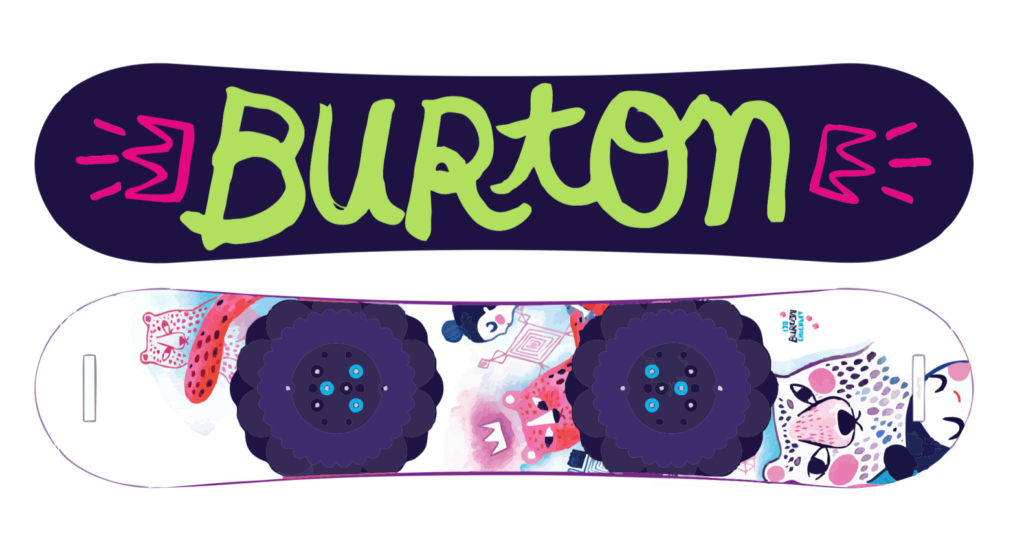
In seventh place is a girls' board developed by Burton. Created specially lightweight for the small weight of young conquerors of the slopes.
Geometry: Twin (same nose and back shape) make the board easy to handle and control.
Deflection: Zero (flat).
The flexibility of the board is the same along its entire length.
Size: from 80 to 130
Advantages:
- Design flexibility reduces the likelihood of breakage;
- Ease;
- Good handling.
Disadvantages:
- Proprietary fastener inserts eliminate the use of third-party fasteners.
PALMER SAGA ROCKER SS12
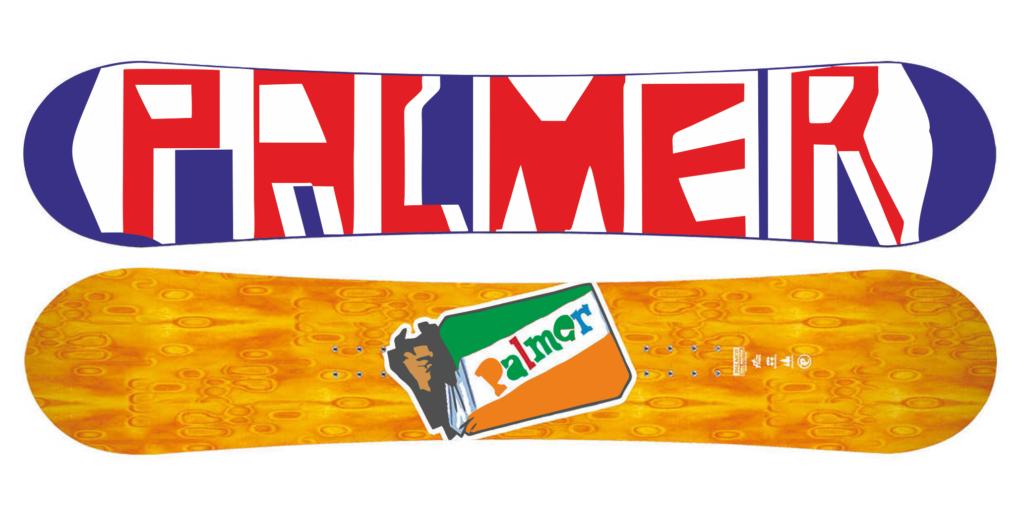
The sixth place is taken by the product of the Austrian company Palmer. This is one of the industry leaders, actively applying new technologies in the production of snowboards. They were the first to obtain a patent for the Kevlar honeycomb used in board cores and most of the CEP sandwiches (hybrid cores).
SAGA ROCKER SS12 is a versatile board for freestyle and freeriding of medium hardness.
Deflection: Rocker. This geometry will allow you to descend both in deep snow and on a rolled track
Core: wood, poplar.
Advantages:
- Ease;
- Versatility.
Disadvantages:
- Not identified.
JONES MOUNTAIN TWIN 2020

Men's snowboard, oriented towards the advanced level.
Not the most budget-friendly option, but beginners don't need such a board yet.
The core is a hybrid bamboo, the fibers of which are laid in different directions, reinforced with fiberglass. Due to this, the board is flexible. Sintered slip with wax applied at the factory.
Hybrid deflection.
The board has a directional geometry, the nose is 20 mm longer relative to the tail.
Advantages:
- High quality workmanship;
- Solid piping;
- Base prepared for skiing.
Disadvantages:
- High price.
ROXY GLOW PACKAGE FLAT W / ER SS20
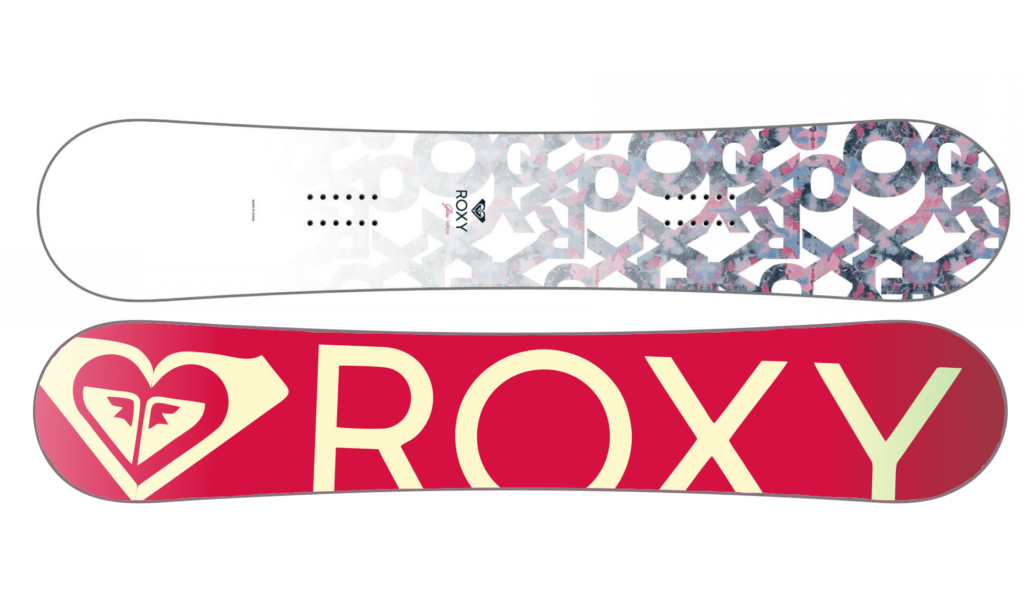
In fourth place is the women's snowboard of the Australian company ROXY. The company was founded in 1990, and initially produced sportswear for women, later expanding the range to include boards and winter clothing.
ROXY does not have its own production in Australia, snowboards for the brand are produced by the American company Mervin Lab.
The board is suitable for beginners and advanced lovers of winter recreation, the flat deflection provides stability, the slide is in full contact with the surface - only the nose and tail are raised.
Purpose: freestyle.
Hardness: 5 out of 10.
Mounting system: classic 2 × 4.
The geometry is symmetrical.
Sizes: 138-149.
Advantages:
- Low weight;
- Good handling;
- Low price.
Disadvantages:
- Limited choice of sizes.
GNU ASYM RECESS BTX
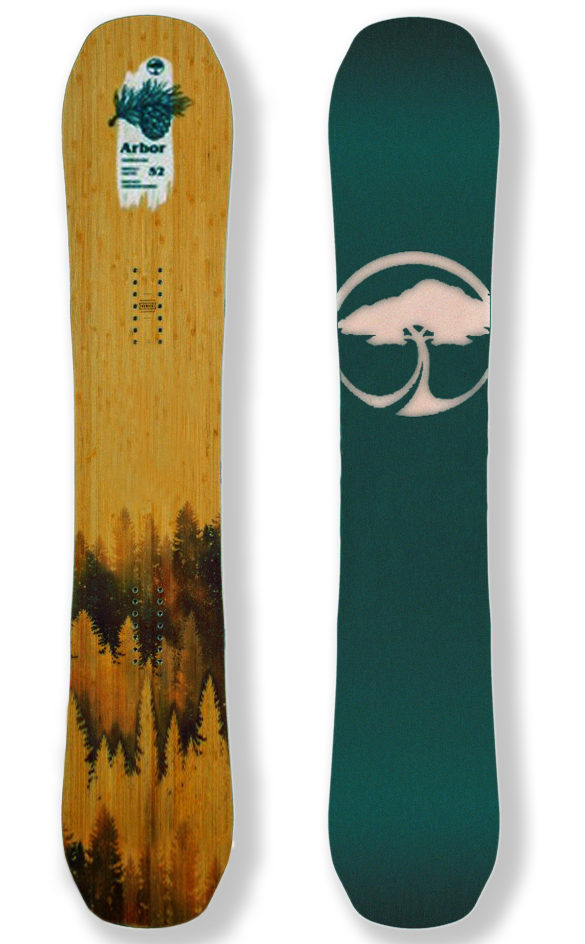
A snowboard for boys, responsive and easy to handle, suitable for those who are just starting to ride. The purpose is universal, the board will be good for freeride and freestyle.
Deflection: hybrid.
Hardness: 4 out of 10.
Slippery: Sintered.
Sizes: 100-125 cm.
The model is available in four types of width - N (narrow) - narrow; MW (mid-wide) is slightly wider than usual, W is wide, UW (ultra wide) is very wide.
Advantages:
- Rolling stability;
- Design versatility.
Disadvantages:
- Not identified.
Arbor SWOON ROCKER
In second place is the female model of medium hardness for experienced athletes.
The core is made of poplar.
Deflection: rocker.
Purpose: Universal.
Geometry: Directional twin.
Sizes: 144 - 152.
Advantages:
- Attractive appearance;
- Excellent sliding properties of the base;
- A large number of embedded holes allow fine balance adjustments.
Disadvantages:
- High price
Burton PROCESS

The first place in the rating is occupied by a model from Burton - a universal snowboard for parks and freeride. Traditional camber provides stability when cornering, while the Twin tip geometry allows for confident tricks.
Proprietary Burton mounts allow you to achieve the perfect balance of the projectile for the rider's tasks.
Hardness: 4 out of 10.
Sizes: 152-162.
Advantages:
- Due to the widened edges in the fastening area, the stability of the board is increased;
- Patented nose and tail shape improves handling.
Disadvantages:
- Proprietary bracing standard eliminates the use of third-party mounts.
Recommendations for practicing snowboarding
- Be careful and prudent on the track when descending and resting. Do not stop in the middle of a descent, this puts other athletes.
- Be predictable in your maneuvers.
- Assess your level of training adequately
- When descending unequipped slopes, carry communication equipment, a first aid kit and avalanche equipment.
If you have experience in operating snowboards, or have any questions and suggestions - share them in the comments.

